Our example: How to recycle electronics. Photoreport
Under the cut about how the largest project on the collection and recycling of equipment in Russia was organized, plus a short tour of the processing plant, where electronics and household appliances are disposed of. The most interesting thing in the primary processing process is the work of separators, which from the ground crumbs of everything and everything emit elements of the desired type. And here, too, there is a place for AI.For about 10 years, we held campaigns to collect and recycle equipment, within which we gave discounts on new purchases. And since the summer of last year, they began to do this on an ongoing basis. And pass the equipmentpossible without additional conditions. It is enough to bring it to the service area of one of our stores participating in the project and fill out the refusal form. Now it can be done in 383 M.Video and Eldorado stores in nine cities and regions (Moscow, Moscow Region, St. Petersburg, Kolpino, Kazan, Volgograd, Yaroslavl, Samara and Ulyanovsk). The export of old large equipment can still be ordered upon delivery of a new one, but in the future we will do a separate service. Through the Association "SKO Electronics-Utilization" we work with a network of processing plants in different regions of Russia. For the convenience of accounting and control, we created a simple IT system in which we register all devices handed over by customers, after which we can track their future fate.Over the past nine months, we have transferred 292 tons of equipment for recycling. In pieces, this is 24,900 units. They brought us a little more than 10 thousand of our customers. Most buyers handed over mobile phones, televisions, home phones, headphones, irons and kettles. And now we want to tell you what happens with this technique. To do this, we went to our partners at the Ecotechprom plant, located in the Moscow Region five kilometers from the Moscow Ring Road.
The most interesting thing in the primary processing process is the work of separators, which from the ground crumbs of everything and everything emit elements of the desired type. And here, too, there is a place for AI.For about 10 years, we held campaigns to collect and recycle equipment, within which we gave discounts on new purchases. And since the summer of last year, they began to do this on an ongoing basis. And pass the equipmentpossible without additional conditions. It is enough to bring it to the service area of one of our stores participating in the project and fill out the refusal form. Now it can be done in 383 M.Video and Eldorado stores in nine cities and regions (Moscow, Moscow Region, St. Petersburg, Kolpino, Kazan, Volgograd, Yaroslavl, Samara and Ulyanovsk). The export of old large equipment can still be ordered upon delivery of a new one, but in the future we will do a separate service. Through the Association "SKO Electronics-Utilization" we work with a network of processing plants in different regions of Russia. For the convenience of accounting and control, we created a simple IT system in which we register all devices handed over by customers, after which we can track their future fate.Over the past nine months, we have transferred 292 tons of equipment for recycling. In pieces, this is 24,900 units. They brought us a little more than 10 thousand of our customers. Most buyers handed over mobile phones, televisions, home phones, headphones, irons and kettles. And now we want to tell you what happens with this technique. To do this, we went to our partners at the Ecotechprom plant, located in the Moscow Region five kilometers from the Moscow Ring Road.Why do I need recycling?
In the total volume of garbage, household appliances and electronics occupy about 7% (hereinafter the figures voiced by the Executive Director of Ecotechprom Vladimir Preobrazhensky). But it is electronic waste that causes 70% of the damage to the environment. All kinds of heavy metals, mercury, freons, oils are present in them. These elements eventually fall into groundwater and poison drinking sources, as well as soil.Where is everything disposed of
As an example, we’ll tell you about one of the partners - the Ecotechprom plant near Moscow, which is part of the Ecopolis Corporation. She owns several refineries operating on the principle of a closed cycle with zero emissions into the environment. Those. in terms of environmental friendliness - a complete order.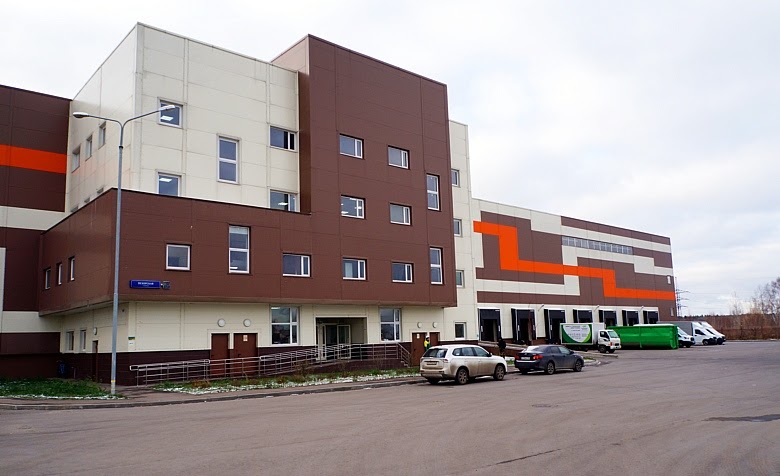 At this enterprise, the equipment is being disassembled into components, grinding and sorting. Final processed products, such as plastic granules or non-ferrous metals, are produced at other enterprises of the corporation.
At this enterprise, the equipment is being disassembled into components, grinding and sorting. Final processed products, such as plastic granules or non-ferrous metals, are produced at other enterprises of the corporation.How is the processing
In general, everything is simple: you need to take the equipment, remove the batteries, picture tubes, pump out the freon from the refrigerators, then send it to the shredder. At the exit, get the crumb, sort it into metals and plastics and transfer it to other plants for further processing.In fact, everything is a little more complicated. And the largest number of technologies is involved in sorting. But let's start in order, from the panorama. Panorama of the main workshop. Photo: EcotechpromThe foreground site is designed to store electronics that will be recycled. On the left is the platform where there is a manual disassembly. To the right in the depths are shredders and separators.Now for the details.
Panorama of the main workshop. Photo: EcotechpromThe foreground site is designed to store electronics that will be recycled. On the left is the platform where there is a manual disassembly. To the right in the depths are shredders and separators.Now for the details.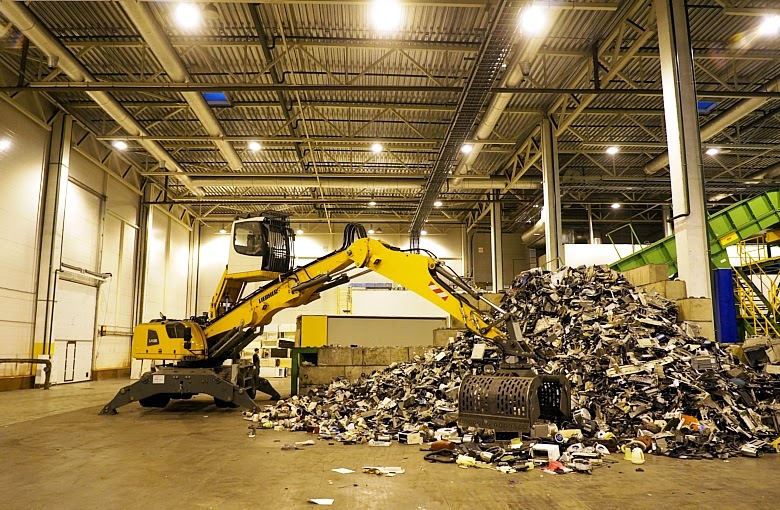 Each newly arrived party is sorted: large household appliances in one direction, everything with picture tubes is on a special stage, and the electronics are simply dumped in huge heaps.
Each newly arrived party is sorted: large household appliances in one direction, everything with picture tubes is on a special stage, and the electronics are simply dumped in huge heaps.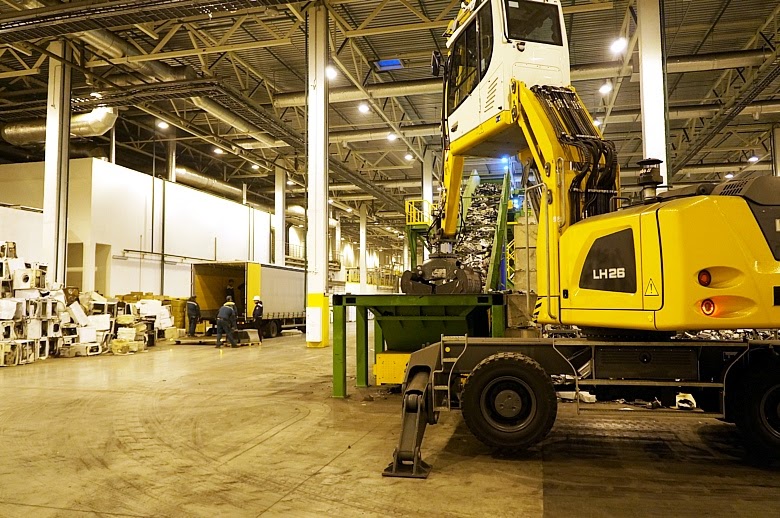 From these heaps, the manipulator takes it to the conveyor, where manual disassembly takes place.
From these heaps, the manipulator takes it to the conveyor, where manual disassembly takes place. Photo: EcotechpromTechnique is untwisted where necessary - help with a hammer, large parts of plastic, glass and iron and wires are separated from each other. Then all this will go to different shredders and separators.Large equipment awaits an industrial shredder. She calls there entirely.The only thing: before this, freon is pumped out of the cooling systems of refrigerators using a special apparatus, which is disposed of separately at other enterprises. It is harmful in that it is able to destroy the ozone layer of the Earth.
Photo: EcotechpromTechnique is untwisted where necessary - help with a hammer, large parts of plastic, glass and iron and wires are separated from each other. Then all this will go to different shredders and separators.Large equipment awaits an industrial shredder. She calls there entirely.The only thing: before this, freon is pumped out of the cooling systems of refrigerators using a special apparatus, which is disposed of separately at other enterprises. It is harmful in that it is able to destroy the ozone layer of the Earth.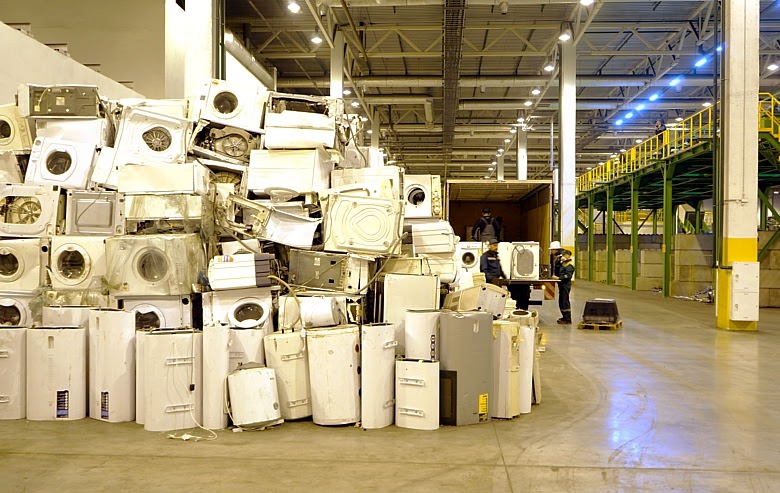
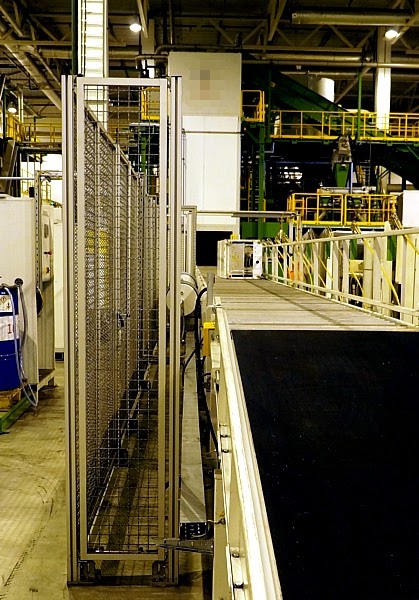 The washing machine drives into the shredder.After the shredder, the separation section begins.
The washing machine drives into the shredder.After the shredder, the separation section begins.How plastics and metals are separated
There are six separators at Ecotechprom. Several eddy current tuned for different types of metals, air, neodymium and optical.Ferrous metals are selected from a common pile with a neodymium magnet.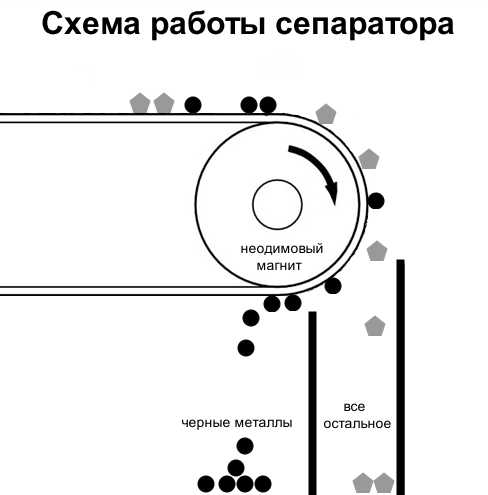 Then the sifting enters the eddy current separators. There, plastic is separated from metals, and various groups of metals are separated from each other.
Then the sifting enters the eddy current separators. There, plastic is separated from metals, and various groups of metals are separated from each other. Mixed non-ferrous metals fall into this container.
Mixed non-ferrous metals fall into this container.
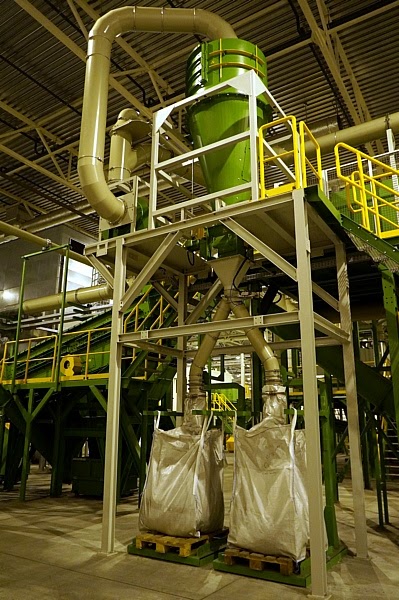
And into these bags - plastics and other crumbs.The principle of operation of the eddy current separator is based on the generated Foucault currents. When it gets into it, the conductive material (where there are free electrons) is pushed out, and the organic material (plastic, rubber) simply falls down.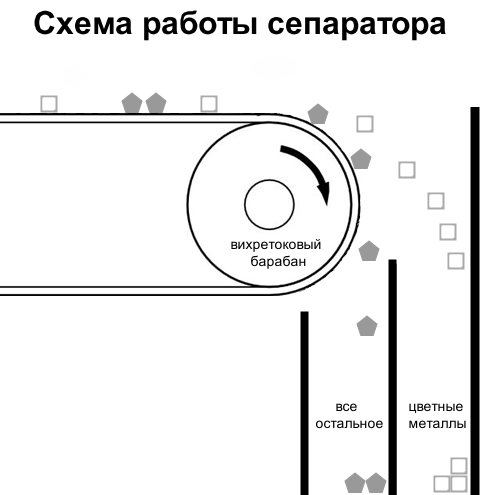
Optical separator
Non-ferrous metals are already sorted on an optical separator. Here it is the most high-tech device. They’ve been conjuring with it for several months already, adding the necessary programs: there were three of them in the basic delivery, and now seven are needed. Potentially, this is the place where the use of AI would be of great benefit. And he will appear here soon.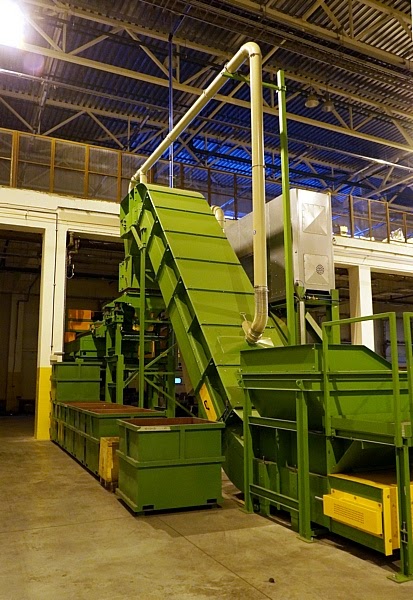 Of course, not only metals can be sorted on this installation. Loaded there is such a crumb:
Of course, not only metals can be sorted on this installation. Loaded there is such a crumb: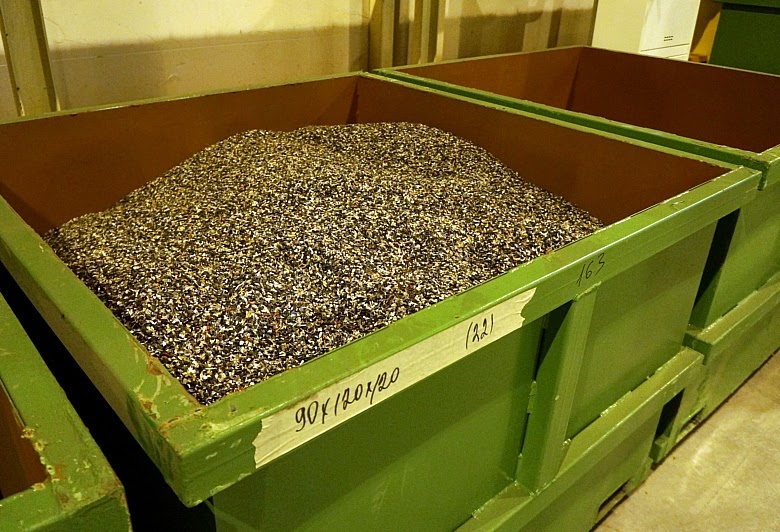
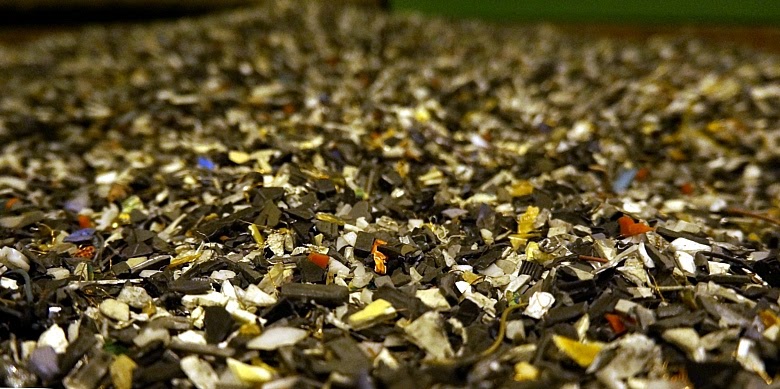
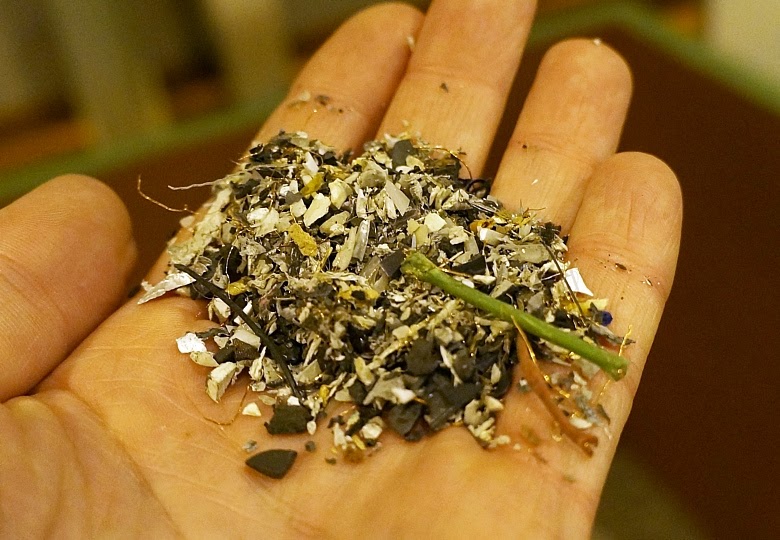 The separator has two key elements: a chamber and an induction sensor. The first captures the size and color, and the sensor responds to metal. The unsorted fraction is carefully fed to the conveyor belt, which, passing through the sensors, ends with a comb with air nozzles and two containers. If the sensors detect the desired element, an injector is activated on the dump from the tape where it is located, knocking it out of the general heap into a separate container. Each time, the separator separates one thing, such as copper, then brass, etc.The story of sorting plastic is a bit different. Since plastics can meet more than 40 species, density separation is used. Make a saline solution in which one floats, the other settles. The density of the solution is controlled by separation. All this happens at another enterprise of the corporation, where plastic chips are transported from Ecotechprom in soft containers (big bags).
The separator has two key elements: a chamber and an induction sensor. The first captures the size and color, and the sensor responds to metal. The unsorted fraction is carefully fed to the conveyor belt, which, passing through the sensors, ends with a comb with air nozzles and two containers. If the sensors detect the desired element, an injector is activated on the dump from the tape where it is located, knocking it out of the general heap into a separate container. Each time, the separator separates one thing, such as copper, then brass, etc.The story of sorting plastic is a bit different. Since plastics can meet more than 40 species, density separation is used. Make a saline solution in which one floats, the other settles. The density of the solution is controlled by separation. All this happens at another enterprise of the corporation, where plastic chips are transported from Ecotechprom in soft containers (big bags).
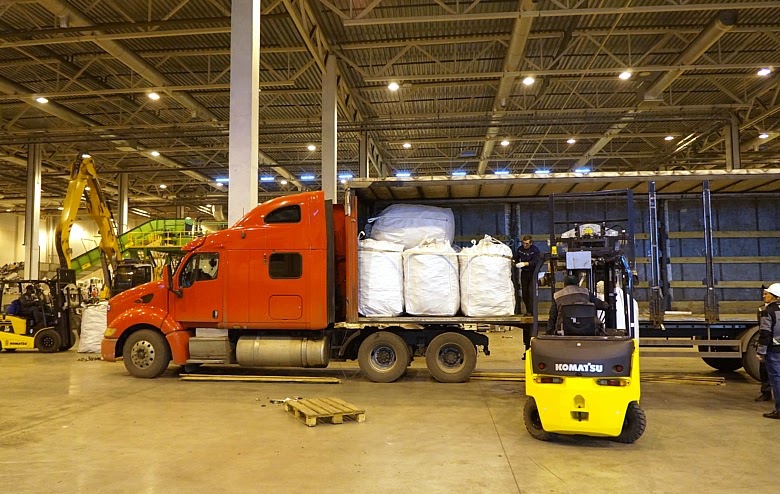
Disposal of hazardous substances
About the pumping of freon from old refrigerators, we have already mentioned above. It is collected in special cylinders and transported for neutralization to a special enterprise.Another environmentally hazardous detail is picture tubes. They contain a huge amount of lead oxide, barium. Also, the phosphor is a danger.For the disposal of picture tubes, the company has several special cameras. There they carefully cut the picture tubes and clean the phosphor with a built-in vacuum cleaner, after which all this goes to a special enterprise that utilizes mercury-containing materials.
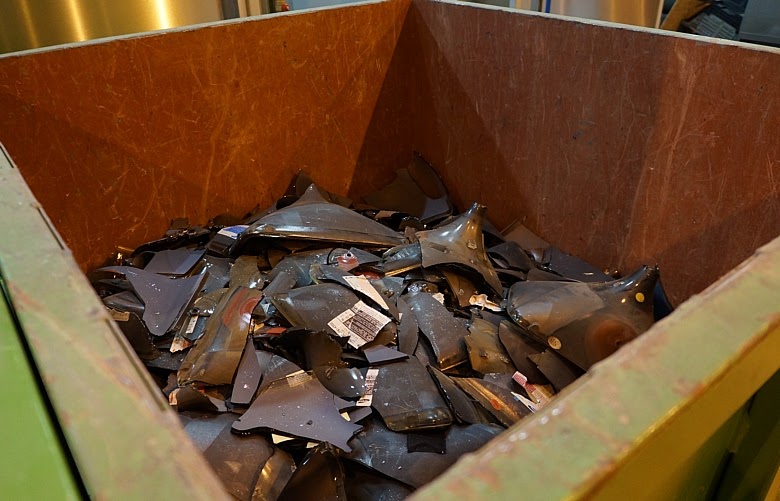 A separate fate awaits batteries and batteries. They are collected at the stage of dismantling equipment and sent to a special enterprise.
A separate fate awaits batteries and batteries. They are collected at the stage of dismantling equipment and sent to a special enterprise.About sales
Recyclable materials are taken by companies that then write in the passport of each of their products that so much and so much is made from recycled materials. Recycled plastic is acquired by manufacturers of containers, sewer pipes, street benches, window sills and bitumen. Heavy plastic from office equipment is quite suitable for this.The main buyers of metals are Severstal and Magnitogorsk Iron and Steel Works. According to the director, the purity of the metal he supplies is 94%, which is almost in line with European standards, where it is fixed at 95%.Here, in general, is the whole story. This year, we plan to launch a recycling scheme in 12 more cities, as well as make it a separate and independent service (if it will be necessary to save the planet from obsolete large-sized equipment with its removal from the installation site). At the same time, small and medium-sized equipment can still be brought to the service areas of our stores and be sure that its disposal will be carried out in accordance with all the rules.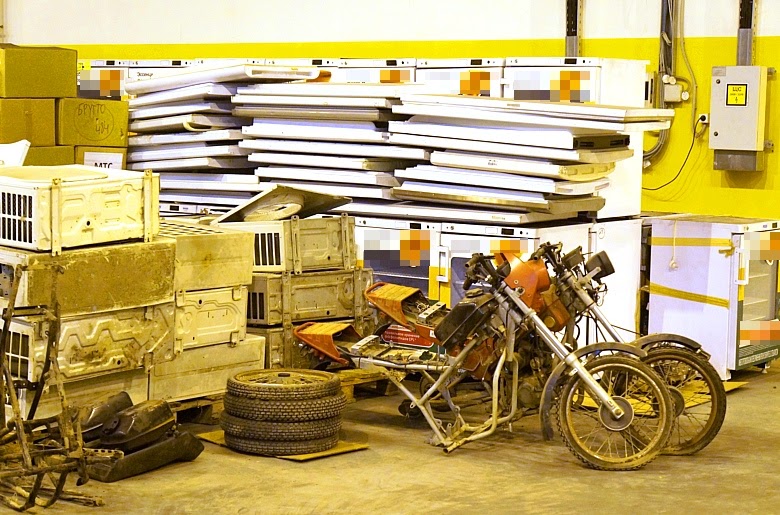 These two motorcycles are the same exotic that our customers also surrendered.
These two motorcycles are the same exotic that our customers also surrendered. Source: https://habr.com/ru/post/undefined/
All Articles